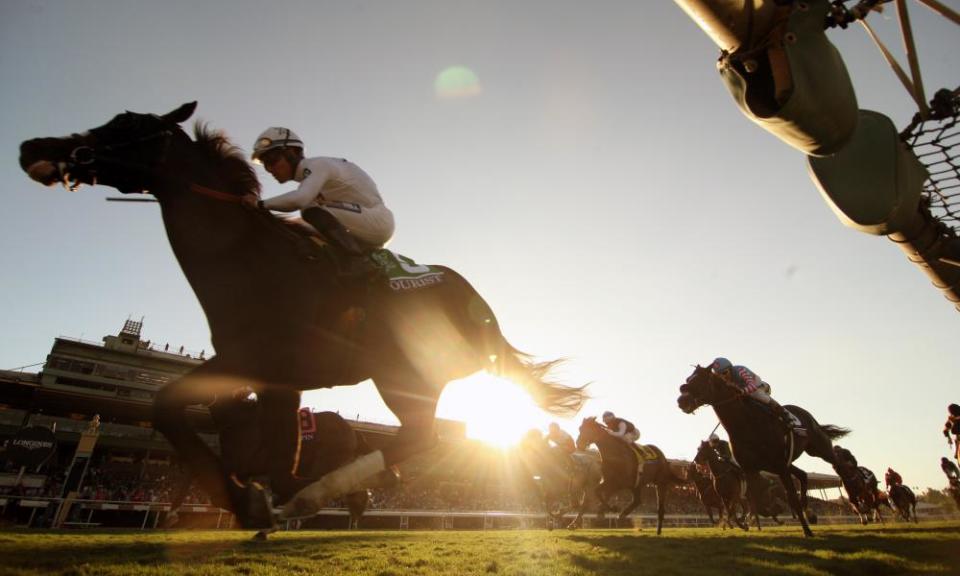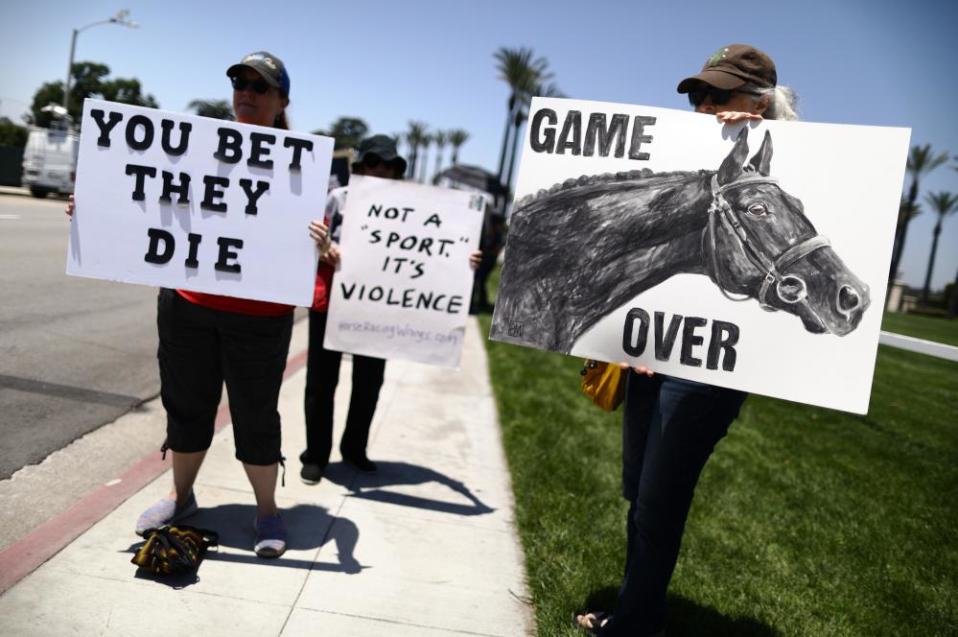'The sport is at a tipping point': Inside US horse racing’s deadly crisis

It’s barely 9.30am at Santa Anita Park racetrack in Los Angeles, but Jennifer Saavedra has been at work for five hours already. Her husband, trainer Anthony, is traveling, and she’s charged with overseeing their small five-horse stable. “I’ll probably get done around six tonight,” she says. Long days are a staple of track life like water is to the Venetians. Not that Saavedra minds: horses are in her “blood,” the 53-year-old says. “You couldn’t keep me away from the track since I could walk.”
But the intense scrutiny the sport in California has been under these past few months – a result of the 30 horses fatally injured at Santa Anita during a six-month period that’s commanded national headlines – has left Saavedra “exceedingly” worried that the existential crisis facing the racing industry could bring about an abrupt end to racing in California. Saavedra describes her involvement in the sport – a world as far removed from the office 9-to-5 as Mercury is from Neptune – as her “passion”. A way of life that’s “more than just a job”, she says.
But the intense scrutiny that horse racing in California has been under these past few months – a result of 30 horses fatally injured at Santa Anita during a six-month period – has left Saavedra “exceedingly” worried that the existential crisis facing the sport could bring an abrupt end to a world she’s been in her “whole life”.
Related: After 15 years at the racetrack, I can no longer watch a horse race | Elizabeth Banicki
The sword of Damocles hanging over horse racing appears no idle threat. “Californians will end horse racing at the ballot box,” promised animal rights activist, April Montgomery, at a California Horse Racing Board (CHRB) meeting in May. It’s not just the racing industry in California that animal rights activists have set their sights on. “We’re going to end it, and it’s going to start with California,” Montgomery warned.
Indeed, though the latest Santa Anita meet ended last month, the conflagration of criticism that engulfed the track during its six-month run shows no signs of burning out. Those flames have already reached other states like Kentucky, where the catastrophic injury rates at Keeneland and Churchill Downs in years past have come under renewed scrutiny. The racing calendar has already moved onto Del Mar and Saratoga – two boutique summer meets that have courted attention in prior years due to spikes in fatalities – and many in the sport are on tenterhooks.
“I’m scared to death,” says Arthur Hancock, owner of Stone Farm in Kentucky. Hancock is part of the Water Hay Oats Alliance (WHOA), a group of industry leaders pushing for a federal medication governing body, overseen by the US Anti-Doping Agency (more on this later). But Hancock says that his fears for the long-term health of the racing industry in the US are shared by some, but not all. “I think there’s sort of a general apathy, and I don’t know where it comes from,” he says.
Others have a slightly different take. Iowa-based Maggi Moss, a former winning-most owner in the country, says that events in the Golden State don’t necessarily give other jurisdictions immediate cause for concern. “I look at what’s happening in California as an island unto its own at the moment,” Moss says. A passionate advocate for racehorse aftercare and drug reform, Moss also believes that some of the equine welfare reforms the state has implemented in recent months – like tightened medications restrictions – are to be applauded.
“Is it too late?” she adds. “Maybe.”
Related: Hall of Fame trainer banned from Santa Anita after latest horse death
So what would happen if racing went the way of the Ringling Bros and Barnum & Bailey circus? For one thing, the financial threads of the horse racing industry are woven deep into the country’s economic tissue, giving employment, directly or indirectly, to nearly half a million individuals.
The industry in California alone supports 17,798 jobs, adds $1.56bn “in value” to the state’s economy, and has a near $2.5bn economic impact, according to the American Horse Council (AHC). According to the CHRB’s own figures, over $3bn was wagered on the racing industry in California alone during the 2017-18 fiscal year. Nationally, the AHC puts the racing sector’s economic impact at around $36.6bn. The connective economic ties between states add another layer.

If Californians suddenly stopped buying horses at the Fasig-Tipton and Keeneland sales in Kentucky, the resulting impact on Kentucky’s economy would be a loss of between $87 and $116 million, according to Steven Vickner, an associate professor in the University of Louisville College of Business’s equine industry program. “That range is the lower bound of economic impact on the state,” says Vickner, emphasizing how his calculations take into consideration a narrow set of factors that a racing ban in California might have. “It ignores things like wagering. It ignores things like boarding, and other aspects of the industry.”
Yet understandably for many, economic considerations play second fiddle to the ethical concerns – issues the public has taken to heart – that continue to evade wholesale industry action: too many horses continue to die on US racetracks, too many horses continue to be funneled into the slaughter pipeline, and too many drugs continue to be used without adequate regulatory oversight. Is major reform now likely?
“I will say it seems to be a strong catalyst for the industry to take the steps necessary to improve equine health,” wrote Jockey Club chairman, Jim Gagliano, in an email. “There is a strong feeling that the sport is at a tipping point and comprehensive changes are being addressed,” he added.
Most, if not all in the industry, are quick to identify the nexus of that change. “If it were not clear before, it should be clear to all of us in racing that horse fatalities are the number one threat to our future and we can let nothing deter us from searching out and eradicating every potential risk to that occurring,” wrote National Thoroughbred Racing Association (NTRA) president and CEO, Alex Waldrop, in a response to questions.
Skeptics, however, say the industry has had ample opportunity for change. For decades prominent figures within the sport and without have made impassioned pleas for reform. What’s more, the industry has proven time and time again that it understands what steps need to be taken to make the sport safer. Just take Del Mar. Three years ago, the track instituted a series of reforms that dramatically slashed the number of fatal equine injuries. New York has reduced the collective catastrophic injury rate at its three venues by 50% since 2012.
So how does the industry make these changes broad-based and lasting? The answer is bound-up within a tangled philosophical and legal debate at the heart of the nation’s governing ethos: states’ rights versus federal law. Added to the mix is the issue of individual rights (like those belonging to certain privately-owned racetracks).
Medication reform is a prime example. Organizations like the Jockey Club and WHOA have thrown their weight behind the Horseracing Integrity Act, a federal bill that will centralize drug reform. Others, like the Association of Racing Commissioners International (ARCI), take the piecemeal approach though the National Uniform Medication Program (NUMP).
Up until June, states representing 95% of pari-mutuel handle had adopted in full the program’s controlled therapeutic substances model rule. But the forward momentum of the NUMP recently hit a bump. That’s because the CHRB voted last month to withdraw from the ARCI, arguing that some of the reforms the state has instituted go further than the organization’s current model rules.
A number of state-wide changes implemented in California followed measures first implemented by The Stronach Group (TSG) at Santa Anita this spring. “I think they’ve made the most significant change in racing in the last generation,” says People for the Ethical Treatment of Animals (Peta) spokesperson Kathy Guillermo. “They [TSG] were a little bit slow to do that, but once they got started, they moved forward very aggressively.”
The steps taken appeared to have a marked impact. No horses were fatally injured at the track for a period of nearly six weeks, though a small cluster of fatalities towards the end of the meet removed much of the shine from that record. Many see Peta’s role in the ongoing debate as contentious, confused by the influence of an organization that has long voiced its bitter opposition to horse racing. On one hand, Guillermo appears to have offered an olive branch if the sport continues to improve its welfare record. But the immediate question many California race-trackers wonder is this: if the state makes further inroads into tackling catastrophic breakdowns, would Peta support the industry if a racing ban made it onto the state ballot? Guillermo evades a definitive answer.
“I think we’d have to figure that out at the time,” she says. “A ballot initiative is very difficult to pass. It is a lot easier to pass regulations and reforms that are going to mean horses don’t suffer so much.”

 Yahoo Sport
Yahoo Sport 





































